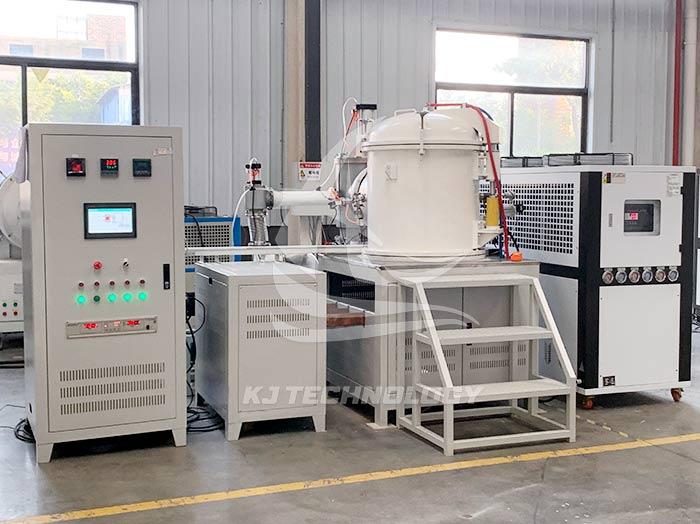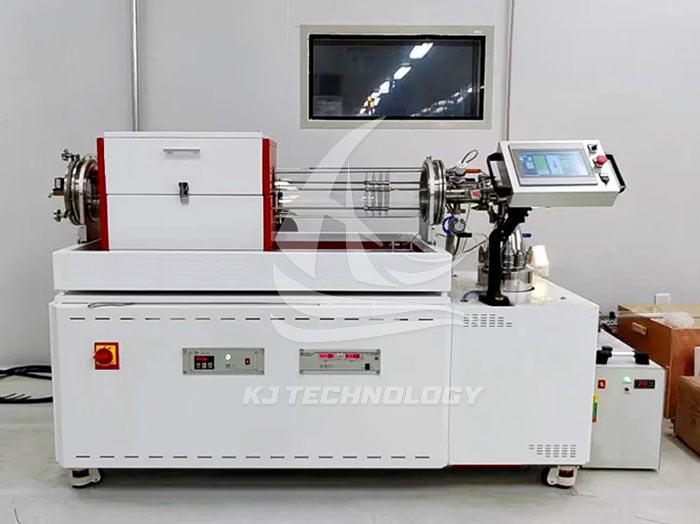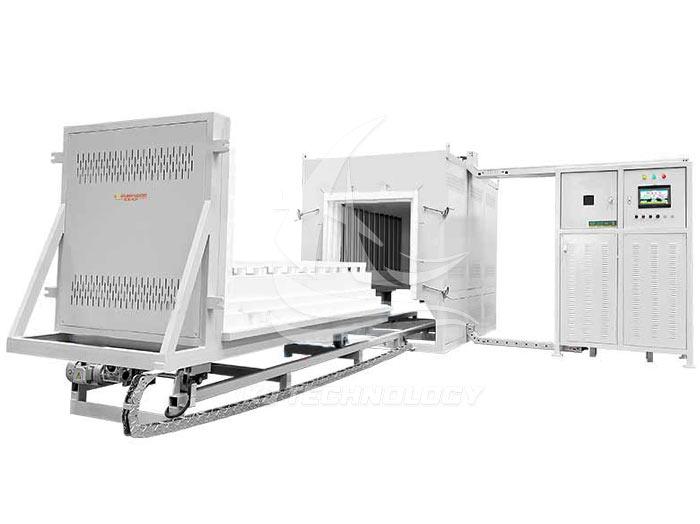Applicable process for lab graphite furnace
 10-23-2025 Author: KJ technology
10-23-2025 Author: KJ technology
The laboratory graphite vacuum furnace is suitable for various processes such as metal sintering, ceramic sintering, composite material preparation, nano material synthesis, high-temperature reduction reaction, and graphitization treatment due to its high temperature capability, vacuum/controllable atmosphere environment, precise temperature control, and material adaptability. The following is a specific analysis of process applicability:
1. Metal sintering process
Preparation of Powder Metallurgy Parts
Application scenarios: Iron/copper based alloy parts such as automotive gears and bearings.
Technological advantages:
Thoroughly eliminate oxygen in a vacuum environment (≤ 10 ⁻ ³ Pa) to avoid density reduction caused by oxidation.
By controlling the atmosphere (such as cracking ammonia degreasing+vacuum sintering) to reduce porosity and improve strength.
Typical parameters: sintering temperature of 800 ℃~1200 ℃, holding time of 1-3 hours, heating rate ≤ 10 ℃/min.
Sintering of titanium alloy medical implants
Application scenarios: biocompatible components such as artificial joints and bone plates.
Technological advantages:
Inert gas (such as argon) protection to prevent titanium oxidation from reducing biocompatibility.
Accurate temperature control (± 5 ℃) to avoid abnormal grain growth and improve fatigue life.
Typical parameters: sintering temperature of 1400 ℃~1500 ℃, vacuum degree ≤ 5 × 10 ⁻ ³ Pa.
2. Ceramic sintering process
Preparation of alumina ceramics
Application scenarios: High hardness ceramic cutting tools, bearings.
Technological advantages:
Sintering under vacuum or nitrogen atmosphere to suppress aluminum volatilization and improve transparency (such as transparent ceramics).
The multi zone temperature control system ensures temperature uniformity and reduces the risk of cracking.
Typical parameters: sintering temperature of 1500 ℃~1650 ℃, holding time of 2-4 hours, heating rate of 5 ℃/min.
Pressure sintering of silicon nitride ceramics
Application scenario: High temperature structural ceramics (such as turbine rotors).
Technological advantages:
The nitrogen atmosphere promotes the nitridation reaction, forming a dense Si-3N ₄ phase.
Graphite molds have good thermal conductivity and shorten the sintering cycle.
Typical parameters: sintering temperature of 1700 ℃~1850 ℃, holding for 3 hours.
3. Preparation process of composite materials
Metal matrix composites (MMC) infiltration sintering
Application scenario: Silicon carbide particle reinforced aluminum based composite materials (wear-resistant parts).
Technological advantages:
Immerse aluminum liquid under vacuum to eliminate gas pores and increase density.
Graphite fired board is resistant to high temperatures and does not contaminate the material.
Typical parameters: immersion temperature of 800 ℃~900 ℃, insulation for 1 hour.
Reaction sintering of ceramic matrix composites (CMC)
Application scenario: Carbon fiber reinforced silicon carbide (C/SiC) brake discs.
Technological advantages:
Under vacuum or argon atmosphere, carbon fibers react with silicon to form SiC, forming a continuous matrix.
Graphite molds are heat-resistant and easy to demold.
Typical parameters: sintering temperature of 1600 ℃~1800 ℃.
4. Nanomaterial synthesis process
Preparation of metal nanoparticles
Application scenario: Silver (Ag) nanoparticles.
Technological advantages:
Vacuum evaporation (1000 ℃~1100 ℃) avoids oxidation and ensures uniform particle size.
The substrate temperature gradient controls the crystal morphology.
Semiconductor nanowire growth
Application scenario: Silicon (Si) nanowires.
Technological advantages:
Vacuum gas-phase transport (1200 ℃~1300 ℃) controls diameter and length.
Graphite boats are resistant to high temperatures and do not introduce impurities.
Typical parameters: Transport gas (Ar), growth time of 30 minutes.
5. High temperature reduction reaction process
Powder metallurgy reduction
Application scenario: Preparation of high-purity metal powders (such as tungsten and molybdenum).
Technological advantages:
Under a hydrogen (H ₂) atmosphere, oxides are reduced to a purity of over 99.9%.
Explosion proof design (hydrogen concentration ≤ 5%) ensures safety.
Typical parameters: Reduction temperature ranging from 1000 ℃ to 1200 ℃.
Purification of Rare Earth Elements
Application scenarios: Rare earth metals such as neodymium (Nd) and dysprosium (Dy).
Technological advantages:
Reduction of hydrogen under vacuum to remove impurities such as oxygen and carbon.
Graphite crucible is corrosion-resistant and does not contaminate materials.
Typical parameters: reduction temperature of 1500 ℃, vacuum degree ≤ 10 ⁻³ Pa.
6. Graphitization treatment process
Graphitization of carbon materials
Application scenario: Final processing of artificial graphite and carbon fiber.
Technological advantages:
Carbon atoms are rearranged to form graphite crystals.
Argon gas protection prevents oxidation and reduces electrical resistivity.
Semiconductor material annealing
Application scenario: High temperature annealing of silicon carbide (SiC) substrates.
Technological advantages:
Eliminate defects and improve crystal quality under vacuum or nitrogen atmosphere.
Temperature uniformity of graphite heater ± 5 ℃.
Typical parameters: Annealing temperature of 1800 ℃, holding for 2 hours.








